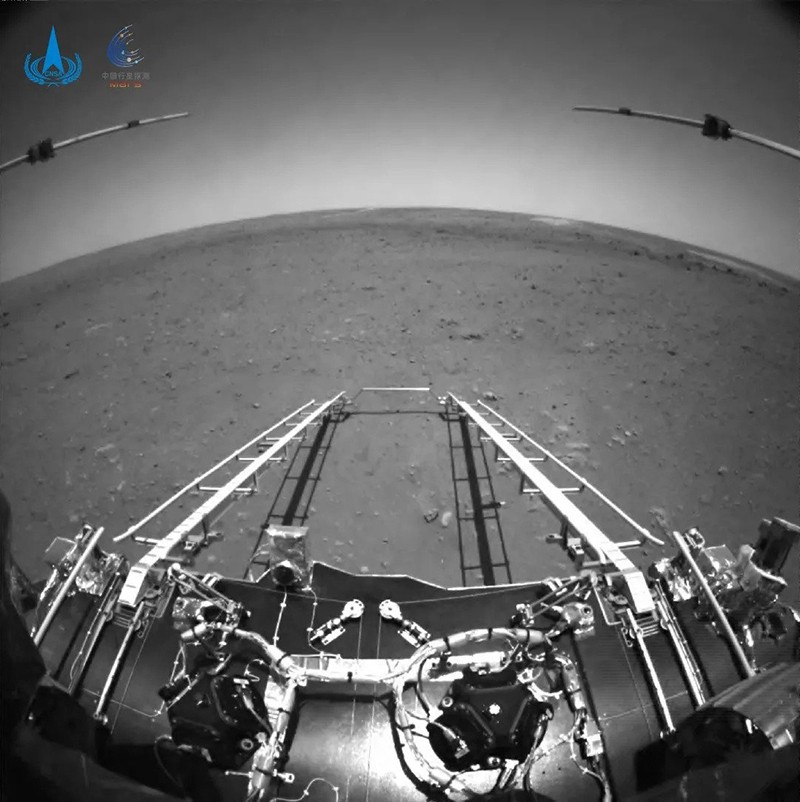Hello Nature readers, would you like to get this Briefing in your inbox free every day? Sign up here
The China National Space Administration has revealed the first images from Mars taken by its Zhurong rover, which landed on Saturday. Scientists say that the shots — which show the rover with its solar panels unfurled and the ramp from its lander deployed — hint that it has arrived at a safe, ideal site from which it can begin exploring. Scientists are thrilled to see that the site appears to be flat and largely free of obstructions — such as craters, rocks and boulders. From there, Zhurong potentially will travel relatively long distances to features of interest seen in satellite imagery.
Nature | 4 min read
Vaccinating people with both the Oxford–AstraZeneca and Pfizer–BioNTech COVID-19 vaccines produces a strong immune response against SARS-CoV-2. Preliminary results from a trial in Spain of more than 600 people are the first to show the benefits of combining coronavirus vaccines. “This is all around wonderful news,” says immunologist Zhou Xing. Some researchers wonder what will happen if people need a third dose to prolong immunity or protect against emerging coronavirus variants. “I do think there’s a brave new world of vaccinology to be scoped in all of this,” says immunologist Daniel Altmann.
Nature | 4 min read
Eight people hospitalized with pneumonia in Malaysia several years ago had evidence of infection with a coronavirus that might have been caught from dogs. A test designed to detect all coronaviruses — even unknown ones — picked up the genetic signature of a canine coronavirus in samples from the people. It’s the first time that a canine coronavirus — which the researchers have named CCoV-HuPn-2018 — has been found in a person with pneumonia. It is not known whether the virus caused the people’s illness, and there’s no evidence that it can pass from person to person. If it is confirmed that the virus causes disease in humans, it will be the eighth unique coronavirus known to do so; others include those that cause some common colds, and SARS-CoV-2, which causes COVID-19.
NPR | 6 min readReference: Clinical Infectious Diseases paper
Features & opinion
Table of Contents
Last month, news reports suggested that researchers at two US universities had been studying the skeletal remains of two Black children, Tree and Delisha Africa, without their families’ knowledge or permission. The girls were killed in the 1985 police bombing of the Black activist group MOVE. It’s just the latest in a series of discoveries in university collections related to the mistreatment of African American human remains, write anthropologists Justin Dunnavant, Delande Justinvil and Chip Colwell. They propose the creation of a law modelled on existing US legislation for Native American remains and cultural items. And they call on universities and museums to catalogue the remains of Black Americans in their collections, and pause research on them — from genomics to archaeology — until they’ve consulted with descendant communities.
Nature | 12 min read
One of the most crucial yet complex steps of commercializing your research is the patent. Patents bestow the seal of approval that your product is a true innovation and your property. In this episode of the Nature Careers Podcast, explore the highs and lows of the patent application process with three researchers who have done the deed and scientist-turned-patent-lawyer Tamsen Valoir.
Nature Careers Podcast | 16 min listen
In a review of biologist Merlin Sheldrake’s new book about fungi, writer Francis Gooding ponders what we can learn from the “decentralised, inquisitive, exploratory and voracious” webs of the mycelial world. Discover the delights of the fungal mind, from the problem-solving ability of slime molds — they’re better at finding the exit from Ikea than we are, apparently — to the melding of human and mushroom through psilocybin.
The London Review of Books | 13 min read

